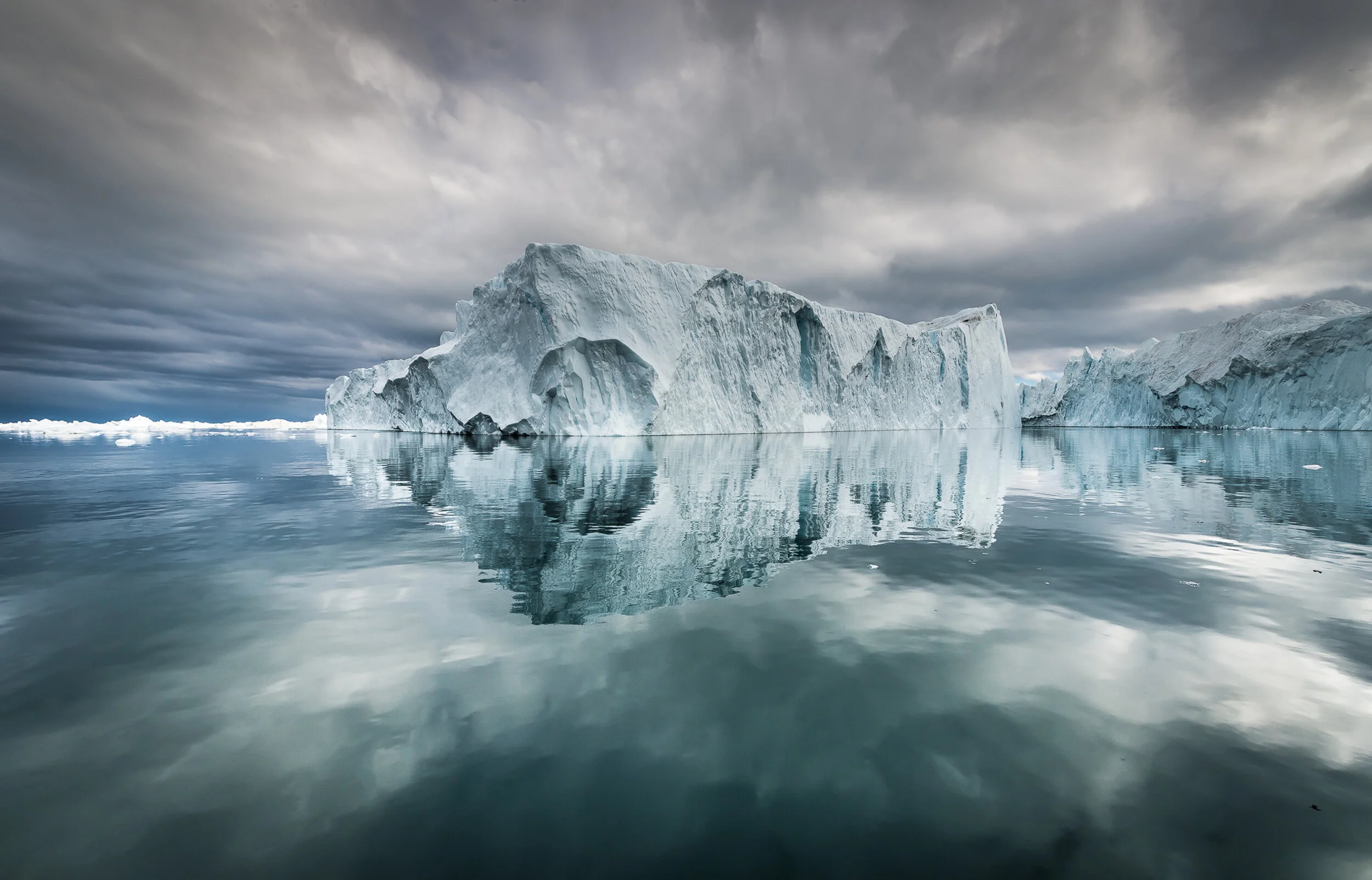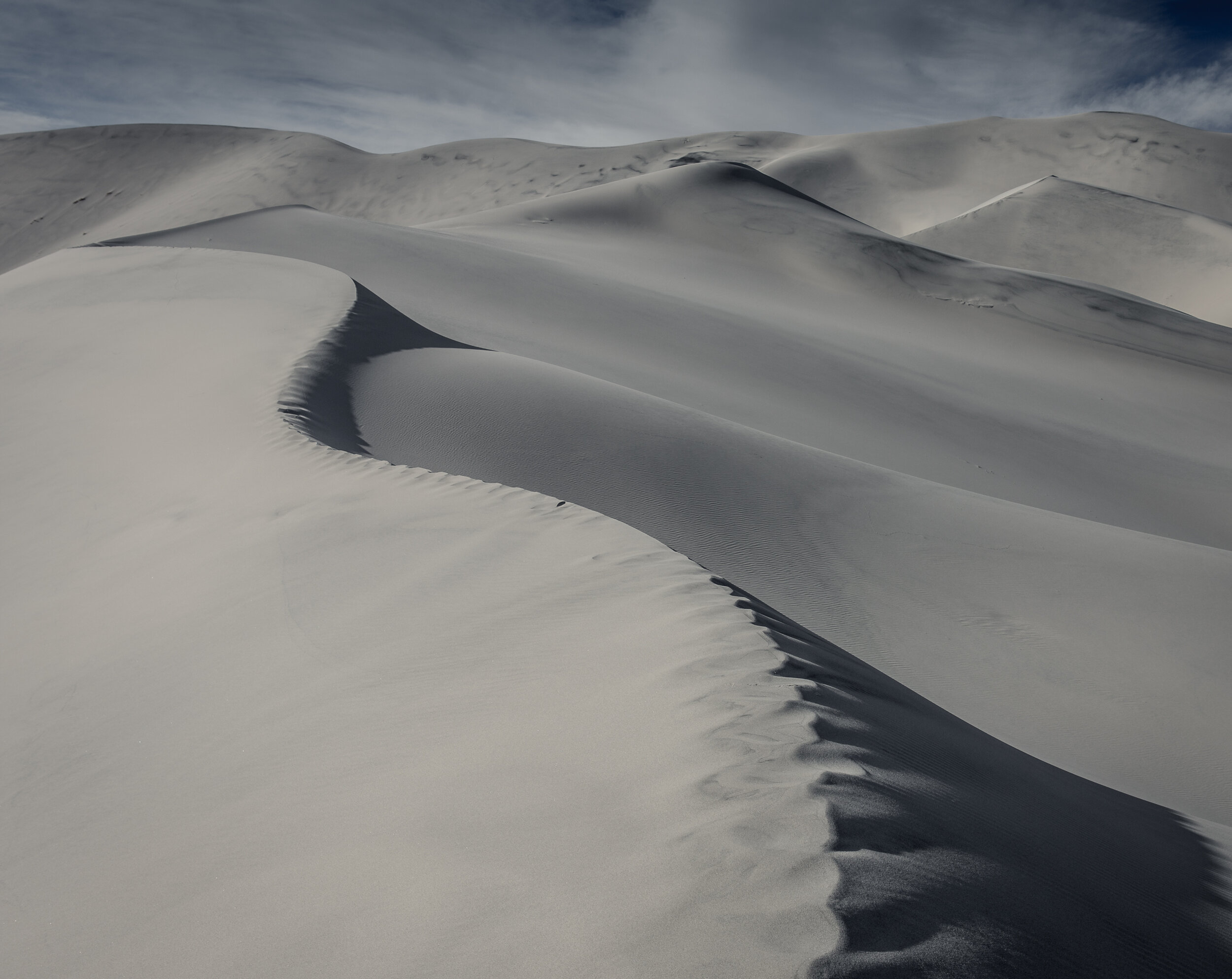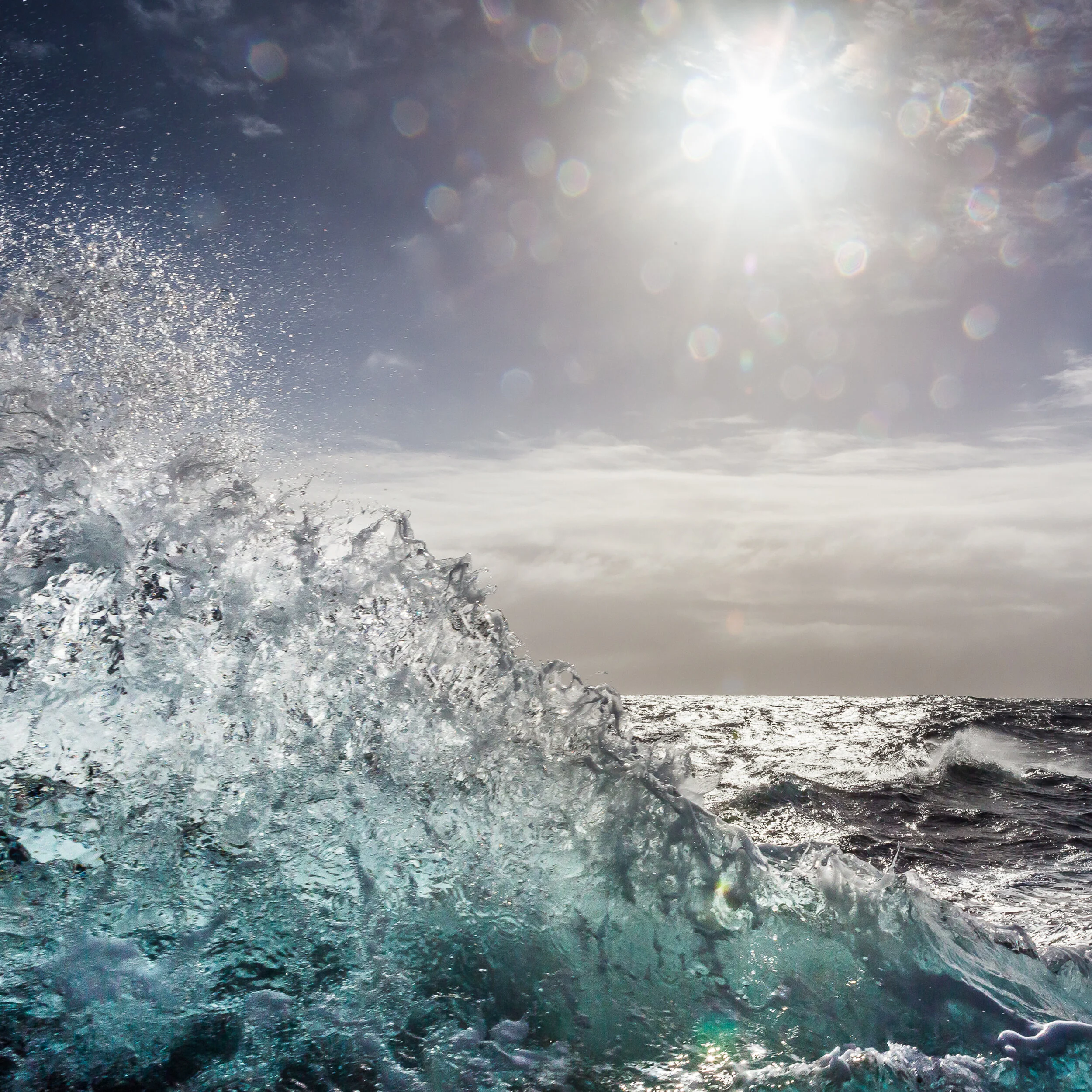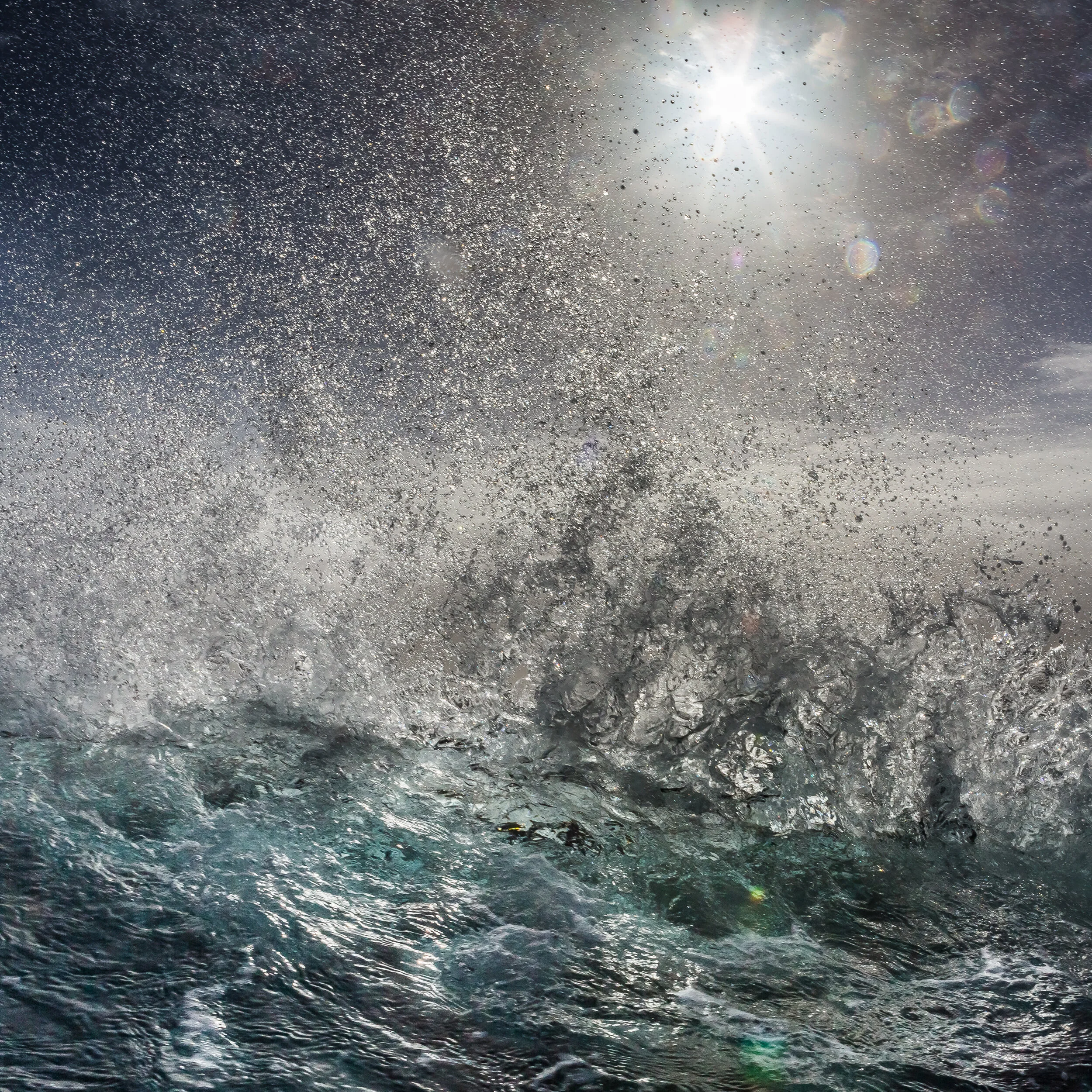Comments on art and inspiration, patience and adrenaline, dark humor and beautiful isolation
Adapted from a wide-ranging interview with Briana Blanchard and Margo Crutchfield at Virginia Tech’s Center For The Arts in preparation for the December 2014 exhibit "Sam Krisch: Elements."
“Death Valley II” was captured at Mesquite Dunes in Death Valley California. The late afternoon light highlighted the dunes in a sensual and almost oceanic way.
“Disko Bay #4” is one of a series of “nature’s mirrors” that were captured in Iceland and Greenland in 2013. I had spent a lot of time trying to create a mirrored effect in Photoshop and hoped that I could achieve a mirror in natural scenes. Within an hour of my first Zodiac ride near the Ilulissat Glacier in Western Greenland I had captured an entire series of images that has continued on subsequent trips.
“Palace”
“Eureka Dunes” was captured at exquisitely large dunes in Death Valley. There is a prehistoric feeling, both in its isolation as well as in its almost anthropomorphic echo of a reptilian spine. These are “Singing Dunes” that mysteriously hum like a beehive at times.
Galaxy Dune
Night Castles
Passage V
Passage VII
Passage VI
How did your interest in photography begin?
I was a camera geek when I was 14. I loved all the tech and the lenses. I had my own darkroom. I shot pictures for the school newspaper and yearbook. I submitted work to local contests. When I went to college I stopped taking my photography seriously. I didn’t pursue it again as an art form until I was 50.
How has your work evolved over time?
I started with street photography and at first I produced highly saturated images that were faint echoes of Jay Maisel. Then found I was drawn to larger, more abstract landscapes with monochromatic looks, often processed in black and white.
Then I found a resonance with landscapes in which scale is not obvious and in which a subtle mood and color dominates. Now, I rarely convert images to straight black and white, and even then I tone them.
My eyes seems to alternate between looking for the detail in crowded scenes and finding a pattern or particular viewpoint in large, lonely expanses.
My iPhone photography seems to embrace both genres and viewpoints, depending on the location, both the found object/observed moment and the larger, moody landscape.
Many of the locations you have photographed are remote and far removed. Why is this? What draws you to photograph a certain place?
Some of it is opportunity, but ultimately it emerges from a series of questions. Should I attempt the journey alone? If not, who will be my travel companions and will their energy help inspire me? What are the dates (sometimes it is as simple as having a week in my schedule and filling it with something that is different and/or difficult)? Is it someplace novel? If not, is it some place that will challenge me in a new way? Will I be intimidated and anxious because of the place’s enormity or the difficulty of the assignment? The last question often leads to new breakthroughs both in technique and interpretation.
Can you tell me about your process (capturing, editing, printing)?
I shoot and have shot with a variety of DSLRs — Canon mainly, but also Nikon and Sony. On the DSLRs I usually use zooms that cover a range from 24mm to 200mm (fairly wide angle to moderate telephoto.) It is not exotic or specialized equipment and it is very accessible.
Looking through the images in this exhibition I see that I have captured all but two in that focal length range and only a few at either extreme.
Not a single image in the exhibition was captured with a camera mounted to a tripod. Aerials and images captured from ships make tripods impractical, but even when I am shooting on land I tend to do better if I can scan the landscape and take multiple angles without having to reset the tripod each time.
There are two exceptions to the range of focal lengths:
“Disko Bay #4” was captured with a 14mm extreme wide angle lens from a small boat.
“Palace” is a three-image stitch from a 16-35mm lens view of a gigantic scene from a ship’s deck.
Processing is initiated in Lightroom where I do RAW conversion and then finished in Photoshop where I do any fine detail work. As in the wet darkroom, there is substantial dodging, burning, sharpening and fine attention to small things for the final print.
My palette is not a very saturated one, nor does it depend on some kind of “objective” relationship with color. I am more interested in how the location speaks to me rather than how it might be portrayed in its brightest or most color saturated form.
Hence, there is a range of color treatment: from the desaturated “Eureka Dunes” and “Deception Island I and II” to the highly colorful and dramatic “Passage” series.
There all also two images — “Galaxy Dune” and “Night Castle” in which I have applied a “Night for Day” technique. I think this helps bring out interesting elements in the images. When the contrast is increased and a blue filter applied the sun brilliantly speckles sand highlights in “Galaxy Dune” and turn an afternoon scene into a galaxy — celestial bodies floating in a night sky. The darkness both obscures and enhances the sensuality of night and the feminine form in the sand dunes. The afternoon sun highlighted in the water in “Night Castle” resembles moonlight on the water and suggests an armed outpost protecting the territory beyond. This shows night in a different context – danger, isolation and the need for security.
It is a challenge printing large work from relatively small files and so there is a lot of additional proofing, attention to noise, and careful resizing of the file before the final print. I coat the prints with a special protective spray.
I print my work using a large format Epson printer with archival pigment digital inks on Ultra Smooth Fine Art Paper. I like the softer, warmer look that this technique gives to the prints.
Most of the time, I frame the prints using a mat, black frames and plexiglass in front of the print. For this exhibition I have used a different technique. I have mounted the prints on archival board and framed them with a thin white frame with no glass or plexiglass to obscure the viewing experience. We decided this would give viewers at this exhibition a more intimate experience relating to the images.
I also experiment with capture and processing in the iPhone, but none of this exhibition’s images are developed with that technique.
Who or what are some of your greatest influences?
While there are many photographers who I have admired over the years, painters and filmmakers are great influences – Orson Welles for his chiaroscuro, wide angles, noir lighting; Hitchcock for his beautifully visualized and controlled scenes; Kubrick for his lighting, angles, pacing and perfection; the Dutch painters for their spectacular lighting and use of dark detail; the Surrealists for mood, irony, and black humor; J.M.W.Turner for his unique use of color and peak action.
How do you think your work is best viewed and experienced?
I am fine with people viewing my images on a website or on a monitor, but I feel that the true completion of my process is in post-processing and printing. Unlike some photographers who shoot digital, but seem to rely only on capture techniques, I don’t view what is in the RAW file as anything but a starting point. The magic for me happens in the digital darkroom. The final print is what I view as the work of art.
How do you see your work going beyond the documentary tradition?
They are recorded from a specific time and place, and in that way are documents. They are interpreted by feeling, thought, my mood, and subconscious expression. In that way, they are creative works.
Throughout your work is the lure of the remote; expansive vistas and an even more expansive silence; a stark but beautiful desolation; and an absence of the human. What compels you to take images of distant places, of sea, of deserts?
I prefer the novel to the familiar, and look for space and unique form to finish the compositions. The lack of the human form in the composition means that I am able to make elements of the compositions the actors in the drama. Every image has a human element which is my eye.
Can you tell me the story behind the Passage, 2014 series?
Landscape photography is a practice of patience, frustration, and occasional adrenaline. Since so much depends on weather and time of day one's entire week can be distilled into ten minutes.
These images were captured on one of those days. The Drake Passage between Argentina and Antarctica has some of the world's roughest seas. This was a day when the seas were active but on which it was possible – with caution – to shoot off of the rear deck of our ship.
Others were taking pictures of birds, but I had a thought before departure of doing a series of images in squares, divided by the horizon line. The active seas and the sun behind created beautiful patterns and wave action. I was able to quickly generate a series of eight images for the series. Then in a few minutes water came over the rail and I rushed inside to dry a dangerously wet camera.
Any other travel stories you’d like to share?
In White Sands, New Mexico I was drawn to the beautiful isolation of the white gypsum dunes. In my second day there, there were interesting clouds on the horizon and I could foresee the emergence of a very dramatic late afternoon light. I hiked out well into the dune field, out of view of other people and a good ways from the safety of my car or other shelter.
What had appeared to be interesting clouds was a gathering storm. I could see the winds start to blow the sands in the distance. Soon the wind had moved quickly towards me and I found myself caught in a rather intense sandstorm for which I was totally unprepared.
For what seemed like a long period (but was probably only a few minutes), I had some trouble breathing and was stung on the legs and face by the pelting of the sand. I knew I had to make my way back to the car, but I also knew that this was a unique moment and one that had to be captured.
As I continued to traverse the dunes I kept turning back to shoot. It was idiotic and prescient, slightly dangerous and exquisite. Afterwards I kicked myself for venturing out alone in precarious weather without protection for myself or for my gear. Lucky for me, I returned without injury and with only a bit of sun and sand burn to show for my troubles. I had produced one of my favorite images.
How do your own personal experiences influence your work?
Even though I have a loving family and a group of extremely wonderful friends, I am a person who craves solitude and needs personal space. I think that is one of the reasons I am drawn to the environments that are remote, exotic, spacious, expansive and challenging.
I have been fortunate to have had the opportunity to use my creative life, whether writing or photography, to express my journeys – both metaphoric and literal. Rather than fighting dark moods, anxiety, drama, irony, a sense of dark humor or other aspects of my personality or history, I embrace them in my work. I hope to communicate those notions and emotions to others. The result for me is a clean, clear feeling of deep connection with the finished work.
If I didn't travel to these large, lonesome places then I would not be able to enjoy or communicate that large, lonesome beauty. Unobserved beauty is beauty intact because the act of observation adds something or changes that beauty. However, it is not the only beauty. This gets into an area of aesthetics, philosophy and science that is well above my level of understanding. I'm just a country photographer.










